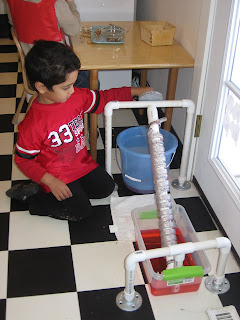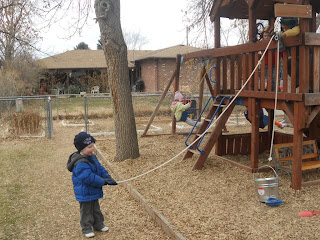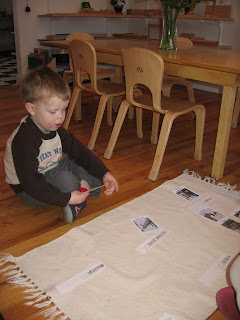

The children have been continuing their study of simple machines. In a Montessori classroom, children are given lessons independently (sometimes with a few other children watching, who have been shown how to be a "quiet observer," who watches the lesson without interrupting in any way). During the lesson, the children are shown how to gather the needed materials, carry out the exercise, repeat as many times as desired, and to put the material away. Once the child has been given a lesson on the material, they are afforded the opportunity to work with the lesson independently (and get it out at will).
Each lesson contains one conceptual "key; " it isolates one important point, satisfying the child's knowledge, and bringing forth one idea or natural law through a concrete, hands-on activity. The lessons are simple, related to the child's needs, fitted to her age and abilities, and easy enough that she can do them herself.
Science lessons are no different. They are not small or large group activities, to be performed and directed by an adult and watched by the children. They are independent lessons which permit the child to be the scientist and explorer, and to discover principles for herself, which she does by repetition. At all times, the independent child is an active participant in the search for understanding (inquiring and discovering for herself), not a passive consumer of pre-formulated information.
As part of this unit, the children have been investigating the many varied uses of screws. In addition to practical life lessons in which the children use screw drivers, hex drivers, and allen wrenches, they have also been learning about the historical use of screws to raise water, using a model of an Archimedes Screw.







The invention of the Archimedes Screw, or screwpump, has been attributed to Archimedes (a student of Euclid)in the third century. It was used to lift water from low lying bodies into irrigation ditches. These ancient machines are still in use today; in 2001 they were successfully used by engineers to stabilize the Leaning Tower of Pisa, they have been used to reclaim land from under the sea in the Netherlands, and they are commonplace in many modern sewage treatment plants.

The children were very interested in this invention and enjoyed hearing stories about Archimedes and about the Siege of Syracuse.
It is not uncommon for Montessori students, after getting a work out independently and repeating it as often as needed to fulfill their needs and satisfy their curiosity, to spontaneously create something new using the information they have learned- a story, a conversation, a drawing, or to share their new accomplishment and validate their own growth by teaching another child to do the work. The way in which the mixed age group accommodates this natural desire to create and to share information with others, it one of the method's most important achievements. To the observant guide, these act of creation demonstrate the ways in which the child has assimilated the new information into their conceptual scheme; additionally, it is quite a delight for the teacher to observe- because it occurs spontaneously, unprompted, and the form in which it appears can differ markedly.
It is not uncommon for Montessori students, after getting a work out independently and repeating it as often as needed to fulfill their needs and satisfy their curiosity, to spontaneously create something new using the information they have learned- a story, a conversation, a drawing, or to share their new accomplishment and validate their own growth by teaching another child to do the work. The way in which the mixed age group accommodates this natural desire to create and to share information with others, it one of the method's most important achievements. To the observant guide, these act of creation demonstrate the ways in which the child has assimilated the new information into their conceptual scheme; additionally, it is quite a delight for the teacher to observe- because it occurs spontaneously, unprompted, and the form in which it appears can differ markedly.
For example, after working with the Archimedes Screw and looking at some of the classroom books, one girl took it upon herself to create this clever diptych of Archimedes. She brought the work over to show me and explained that she had drawn Archimedes as a child and Archimedes as an adult "because all people were a baby and a child once, you know." What a lovely portrait, and a nice consolidation of what she had learned about Archimedes, history, biology, and the lifecycle of a person. 







In addition to learning about screws, the children have been investigating pulleys. They have been performing experiments with fixed pulleys and block and tackle hoists (a system of two or more pulleys with a rope threaded between them) to learn that pulleys redirect force (you pull down on the rope, but the pulley pulls up on the load) and that a single pulley will not amplify the force (you will have to pull just as hard to lift the load with the pulley) but multiple pulleys (like the block and tackle system) provide mechanical advantage. The children also had the opportunity to experiment with different methods of rigging a tackle.








After the children had been working with the classroom models for a few days, my husband when out to the yard one afternoon and put up a pulley in the play area. The children peered through the glass and excitedly watched him at his work as they finished their lunches. "He has a surprise for us," one boy told me confidently. Afterwards, they raced outside to take turns using it as a fixed pulley and as a block and tackle hoist.
 The children learned to belay, carefully lifting and lowering their load using a hand over hand motion.
The children learned to belay, carefully lifting and lowering their load using a hand over hand motion.

 Using the pulley has become a favorite past time in the yard.
Using the pulley has become a favorite past time in the yard.
 The children have also been experimenting with some compound machines that use pulleys. This simple system uses a crank on a wheel and axle, in addition to a pulley, and gives the children some experience with the uses of a crane and winder.
The children have also been experimenting with some compound machines that use pulleys. This simple system uses a crank on a wheel and axle, in addition to a pulley, and gives the children some experience with the uses of a crane and winder.

 Two of the younger children amused me greatly by getting out this material together and using it while they collaborated on a song which included lyrics about "we are the best workers because we work hard all day long." To my amusement, they got the material out together on multiple occasions, always singing the same homage to revered "workers".
Two of the younger children amused me greatly by getting out this material together and using it while they collaborated on a song which included lyrics about "we are the best workers because we work hard all day long." To my amusement, they got the material out together on multiple occasions, always singing the same homage to revered "workers".

 Cranes were invented in ancient Greece. The earliest models were powered by beasts of burden, but the Romans developed more powerful cranes which employed the use of human treadmills like this reconstruction from Bonn, Germany.
Cranes were invented in ancient Greece. The earliest models were powered by beasts of burden, but the Romans developed more powerful cranes which employed the use of human treadmills like this reconstruction from Bonn, Germany.
 The children learned to belay, carefully lifting and lowering their load using a hand over hand motion.
The children learned to belay, carefully lifting and lowering their load using a hand over hand motion.
 Using the pulley has become a favorite past time in the yard.
Using the pulley has become a favorite past time in the yard. The children have also been experimenting with some compound machines that use pulleys. This simple system uses a crank on a wheel and axle, in addition to a pulley, and gives the children some experience with the uses of a crane and winder.
The children have also been experimenting with some compound machines that use pulleys. This simple system uses a crank on a wheel and axle, in addition to a pulley, and gives the children some experience with the uses of a crane and winder.
 Two of the younger children amused me greatly by getting out this material together and using it while they collaborated on a song which included lyrics about "we are the best workers because we work hard all day long." To my amusement, they got the material out together on multiple occasions, always singing the same homage to revered "workers".
Two of the younger children amused me greatly by getting out this material together and using it while they collaborated on a song which included lyrics about "we are the best workers because we work hard all day long." To my amusement, they got the material out together on multiple occasions, always singing the same homage to revered "workers".
 Cranes were invented in ancient Greece. The earliest models were powered by beasts of burden, but the Romans developed more powerful cranes which employed the use of human treadmills like this reconstruction from Bonn, Germany.
Cranes were invented in ancient Greece. The earliest models were powered by beasts of burden, but the Romans developed more powerful cranes which employed the use of human treadmills like this reconstruction from Bonn, Germany.  Additionally, the children have also been experimenting with levers. Levers help to teach students the basic idea of torque (something revolving around a pivot point and the notion that you get a bigger torque by using a bigger force or applying the force further from the pivot point), equilibrium (the idea that under certain conditions objects can be balanced), and the parts of a lever (bar, fulcrum).
Additionally, the children have also been experimenting with levers. Levers help to teach students the basic idea of torque (something revolving around a pivot point and the notion that you get a bigger torque by using a bigger force or applying the force further from the pivot point), equilibrium (the idea that under certain conditions objects can be balanced), and the parts of a lever (bar, fulcrum).We have several models of levers in the classroom, including one in which the children can create class two levers (where the fulcrum is at the end and the applied force is at the end), but the universal favorite of the children is this lever in which they experiment with lifting a fixed load of five washers. The children begin with the fulcrum in the middle of the bar and hypothesize how many washers must be applied to the force side to lift the load of five washers (6). Then, they experiment with moving the fulcrum closer to the load and discover that it requires less force to lift the same load (4). By changing the position of the fulcrum, and using such a simple system for comparing force (quantities of washers rather than known masses), even children with limited mathematical knowledge can readily note the force amplifications and understand the relationships among the different distances and forces.
I was particularly pleased when, after a few minutes of working with this material, one kindergarten age girl informed me that she had noticed that when nothing was on it, the bar only balanced when the fulcrum was placed in the middle of the bar. She was very excited about showing her discovery to the other students. These "aha moments," and the thrill of discovering something for herself through observation and experimentation, are lost in group settings where teachers present information to children, rather than creating the conditions where they can come to the same conclusion through their own mental efforts.



Once the children had a good understanding of the idea of torque and equilibrium, it was time to bring out the balance scale and introduce the idea of measuring using known masses.




The children have also been busy applying their knowledge about simple machines through conceptual sorting activities like this one. In this lesson, they examine pictures of simple machines that can be found in their homes and environment and sort them based upon the type of simple machine represented. This is a pretty abstract (and challenging) task for a three- six year old!

 We have also been studying the art of Leonardo Da Vinci; many of the children made Inventor's Journals featuring tracings and sketches of simple machines in the style of Da Vinci's journals.
We have also been studying the art of Leonardo Da Vinci; many of the children made Inventor's Journals featuring tracings and sketches of simple machines in the style of Da Vinci's journals.






 Next week, we will be introducing lessons on magnetism and electricity into the classroom.
Next week, we will be introducing lessons on magnetism and electricity into the classroom.

 We have also been studying the art of Leonardo Da Vinci; many of the children made Inventor's Journals featuring tracings and sketches of simple machines in the style of Da Vinci's journals.
We have also been studying the art of Leonardo Da Vinci; many of the children made Inventor's Journals featuring tracings and sketches of simple machines in the style of Da Vinci's journals.


The children were also enamored with David Macaulay's book The New Way Things Work. They spent many an afternoon leafing through the pages of the book, examining simple machines, and it afforded the inspiration for many depictions of "pirate ships" that had lever "ship shakers" like those Archimedes is said to have designed for the Siege of Syracuse.



 Next week, we will be introducing lessons on magnetism and electricity into the classroom.
Next week, we will be introducing lessons on magnetism and electricity into the classroom.

No comments:
Post a Comment